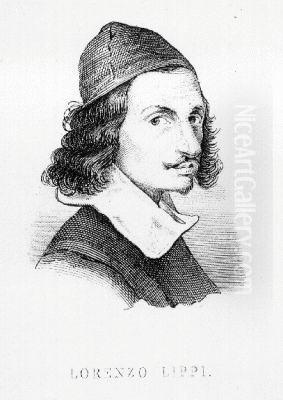
Lorenzo Lippi (1606–1665) stands as a significant, if sometimes understated, figure in the landscape of 17th-century Italian art. A native of Florence, he remained deeply connected to his city throughout his life, contributing to its rich artistic and literary traditions. As both a painter and a poet, Lippi carved a unique niche for himself, characterized by a commitment to naturalism in his art and a sharp, satirical wit in his literary endeavors. His work reflects the artistic currents of the Florentine Seicento, a period that, while influenced by the broader Italian Baroque, often retained a characteristic Tuscan restraint and a deep respect for the principles of Renaissance drawing and composition.
Early Life and Artistic Formation in Florence
Born in Florence in 1606, Lorenzo Lippi's artistic journey began under the tutelage of Matteo Rosselli (1578–1650), a leading painter in the city at the time. Rosselli's workshop was a prominent training ground, and his style, which blended late Mannerist elegance with a move towards greater naturalism and clarity influenced by the Counter-Reformation, provided a solid foundation for Lippi. Rosselli himself was a prolific artist, known for works like the "Triumph of David" and numerous altarpieces and frescoes that adorned Florentine churches and palaces. From Rosselli, Lippi would have absorbed a strong emphasis on proficient draughtsmanship (<em>disegno</em>), a hallmark of Florentine art since the Renaissance.
Beyond his immediate master, Lippi was a keen student of earlier Florentine and Central Italian masters. He is known to have particularly admired the work of Santi di Tito (1536–1603), a key figure in the Counter-Reformation art movement in Florence. Santi di Tito's emphasis on clear narrative, legible compositions, and naturalistic figures, moving away from the complexities of late Mannerism, resonated with Lippi's own developing sensibilities. Another significant influence was Federico Barocci (c. 1535–1612) from Urbino, whose soft sfumato, tender emotionality, and vibrant yet harmonious color palette left an impression on many artists of the period, Lippi included. Barocci's ability to convey deep religious sentiment with grace and naturalness was particularly admired.
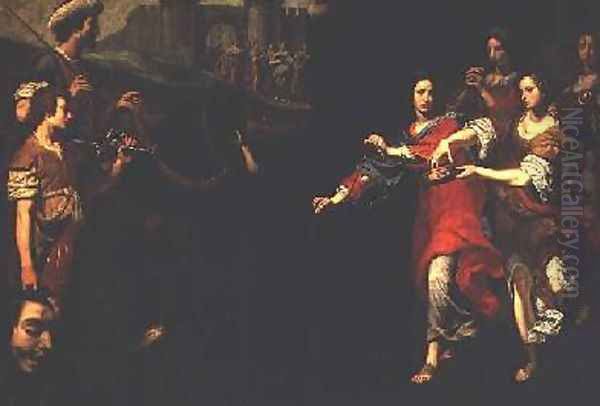
Lippi's artistic education was thus rooted in a Florentine tradition that valued clarity, naturalism, and technical skill. While the more dramatic and dynamic aspects of the High Baroque, as practiced in Rome by artists like Gian Lorenzo Bernini or Pietro da Cortona, were known, Florentine taste often leaned towards a more measured and composed aesthetic.
The Distinctive Style of Lorenzo Lippi: Naturalism and Restraint
Lorenzo Lippi’s mature artistic style is characterized by its commitment to naturalism and a certain sobriety that distinguished him from some of his more flamboyant Baroque contemporaries. He eschewed overt theatricality and exaggerated emotionalism, preferring instead a more direct and unadorned representation of his subjects, whether religious, mythological, or portraits. This pursuit of "truth" in representation was a conscious choice, aligning him with a strand of naturalism that had roots in the work of Caravaggio (1571-1610), though Lippi’s interpretation was less dramatic in its use of chiaroscuro and more focused on clear, even lighting and precise rendering of form.
His figures are often solid and well-defined, with a tangible sense of presence. He paid close attention to the rendering of textures, fabrics, and individual physiognomies, lending an air of authenticity to his scenes. This meticulous approach is evident in his drapery, which is typically rendered with a careful understanding of fold and weight, contributing to the three-dimensional quality of his figures without resorting to excessive agitation.
Lippi's color palette is generally warm and harmonious, often employing rich reds, deep blues, and earthy tones. While capable of vibrant passages, his use of color tends to support the overall naturalistic effect rather than drawing attention to itself through startling contrasts or overly saturated hues. His compositions are typically well-balanced and clearly structured, reflecting the enduring Florentine emphasis on good design. Even in multi-figure compositions, there is a sense of order and legibility that makes the narrative easy to follow.
This stylistic inclination towards naturalism and clarity can be seen as a continuation of the reforms initiated by artists like Santi di Tito in the late 16th century, and as a Florentine response to the broader European trend towards realism in the 17th century, seen in the works of Spanish masters like Diego Velázquez or Dutch painters like Rembrandt, albeit with a distinctly Italian flavor.
Major Themes and Representative Works
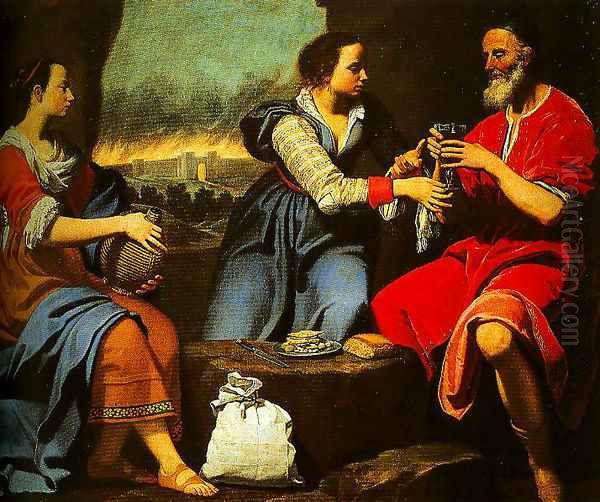
Lorenzo Lippi's oeuvre encompasses a range of subjects, including religious scenes, mythological narratives, and portraiture. His religious paintings often depict biblical episodes with a focus on human emotion and interaction, rendered with his characteristic naturalism.
One of his notable works is "Christ and the Samaritan Woman" (c. 1644). This painting exemplifies Lippi's style, with its clearly delineated figures, calm composition, and attention to realistic detail. The interaction between Christ and the woman is portrayed with a quiet dignity, and the landscape setting, though conventional, is rendered with care. The figures are solid, their gestures natural, and the narrative is conveyed with directness.
Another significant painting is "The Triumph of David" (Galleria Corsini, Florence). This work showcases Lippi's ability to handle a multi-figure composition with clarity. David, holding the head of Goliath, is presented not with overt heroic bombast, but with a more restrained sense of victory. The surrounding figures react with a range of natural emotions, and the overall scene is imbued with a sense of narrative coherence.
Lippi also painted allegorical subjects. His "Allegory of Simulation" (Musée des Beaux-Arts, Angers) is a fascinating work that demonstrates his intellectual engagement as well as his artistic skill. The painting depicts a woman holding a mask, a common symbol of deceit or pretense, surrounded by other symbolic elements. The execution is precise, with a smooth finish and careful attention to the textures of fabric and flesh.
His "Lot and His Daughters" is another example of his biblical narratives, treating a dramatic Old Testament story with his characteristic blend of naturalism and compositional order. The emotional turmoil of the figures is conveyed, but within a framework of controlled artistry.
In the realm of portraiture, Lippi was sought after for his ability to capture a sitter's likeness with honesty and without excessive flattery. His portraits, like his other works, are marked by their directness and solid rendering. While perhaps not as psychologically penetrating as some of his contemporaries in other regions, they possess a dignified realism.
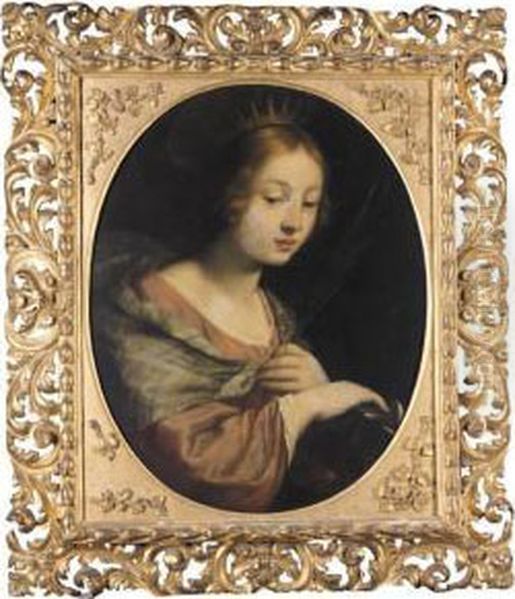
Other works attributed to him or representative of his style include paintings like "Saint Catherine of Alexandria," "The Sacrifice of Isaac," and "The Virgin Glorified by Saints." These titles, often generic, point to his engagement with standard religious iconography, which he would have approached with his typical stylistic concerns. A drawing like "Young Woman Holding a Jug" (a red chalk study) reveals his working process, showing his careful study of form and pose, likely as a preparatory sketch for a larger painted composition.
Literary Pursuits: "Il Malmantile Racquistato"
Beyond his achievements as a painter, Lorenzo Lippi was also a respected poet. His most famous literary work is "Il Malmantile Racquistato" (The Reclaimed Malmantile), a mock-heroic epic poem published posthumously in 1676 (though written much earlier) under the anagrammatic pseudonym Perlone Zipoli. This lengthy poem, written in ottava rima, is a humorous and satirical work, rich in Florentine dialect, proverbs, and colloquialisms.
The poem narrates the fantastical siege of the castle of Malmantile, weaving together a tapestry of bizarre characters, comical battles, and witty observations on Florentine society and human foibles. It is considered a masterpiece of Italian burlesque poetry and is valued for its linguistic richness and its vivid, if exaggerated, portrayal of popular Florentine life and customs of the time. The humor is often earthy and robust, and the poem is filled with playful allusions and parodies of classical epic conventions.
The creation of "Il Malmantile Racquistato" reveals another dimension of Lippi's intellect and creativity. It demonstrates his deep immersion in Florentine culture, not just its high art traditions but also its vernacular language and popular imagination. The poem's enduring popularity attests to his skill as a wordsmith and his keen sense of humor. This dual talent as painter and poet was not unique in Italian history – Michelangelo being the most famous example – but it certainly distinguished Lippi among his 17th-century contemporaries.
The Florentine Artistic Milieu and Contemporaries
Lorenzo Lippi operated within a vibrant, if somewhat conservative, artistic environment in 17th-century Florence. The Medici family, though still patrons of the arts, did not commission grand-scale projects with the same frequency as in earlier centuries, and the artistic scene was perhaps less innovative than in Rome or Naples. Nevertheless, Florence maintained a strong tradition of craftsmanship and a distinct artistic identity.
Lippi's teacher, Matteo Rosselli, was a dominant figure. Other notable Florentine painters active during Lippi's lifetime included:
Jacopo Vignali (1592–1664): A fellow pupil of Rosselli, Vignali's style was characterized by a soft, painterly quality and a gentle emotionalism.
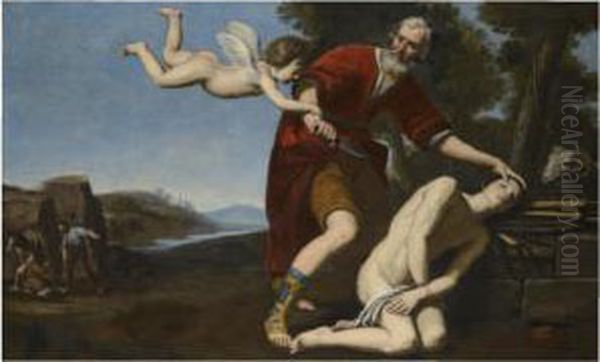
Francesco Furini (1603–1646): Known for his highly sensual and sfumato-laden depictions of female figures, often from mythology or the Old Testament. His style was more overtly sensuous and less naturalistic than Lippi's.
Cesare Dandini (1596–1657): Another prominent Florentine, Dandini painted elegant and refined figures, often with a polished, enamel-like finish. His work shows a sophisticated blend of idealism and observation.
Felice Ficherelli, nicknamed "Il Riposo" (1605–c. 1660): Known for his dramatic and sometimes unsettling depictions of biblical and mythological scenes, often with a strong chiaroscuro.
Giovanni Martinelli (c. 1600/1604–1659): An artist whose work sometimes shows Caravaggesque influences in its lighting and realism, particularly in his earlier period.
Baldassare Franceschini, known as Il Volterrano (1611–1690): A younger contemporary, Volterrano became a leading fresco painter in Florence, known for his illusionistic ceilings and dynamic compositions, more aligned with the High Baroque style.
While Lippi's style was distinct, he was part of this broader Florentine school that valued technical skill and often displayed a certain restraint compared to the more exuberant Baroque styles elsewhere in Italy. The legacy of earlier Florentine masters like Andrea del Sarto (1486-1530), with his classical balance and harmonious color, continued to be felt.
Looking beyond Florence, the Italian artistic landscape was rich and varied. The revolutionary naturalism of Caravaggio had already transformed painting in the early part of the century. The classical idealism of the Carracci, particularly Annibale Carracci (1560-1609), offered another powerful direction. In Rome, artists like Guido Reni (1575-1642) and Guercino (Giovanni Francesco Barbieri, 1591-1666) developed influential styles that blended idealism with naturalism and dynamic composition. The High Baroque was in full swing with figures like Pietro da Cortona (1596-1669) creating vast, energetic frescoes. Female artists like Artemisia Gentileschi (1593 – c. 1656) also made significant contributions with their powerful and dramatic interpretations of biblical and historical subjects. Lippi's work, while perhaps less internationally renowned than some of these figures, represents an important regional expression of Baroque art.
Anecdotes and Personality: The Correggio Incident
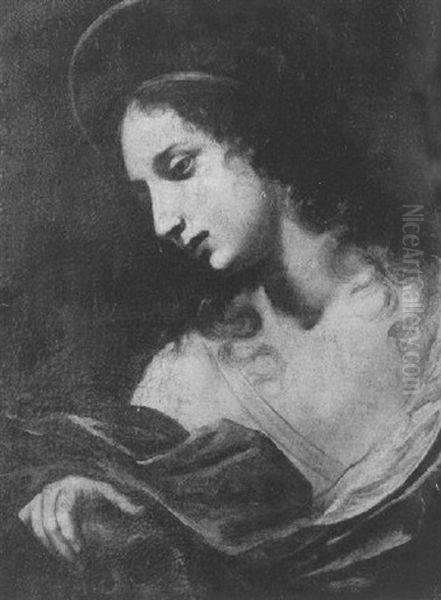
An anecdote often recounted about Lorenzo Lippi sheds light on his personality and artistic self-assurance. It is said that during a visit to Parma, he was shown works by the great High Renaissance master Antonio Allegri da Correggio (c. 1489–1534). Correggio was renowned for his incredibly soft modeling of figures, his illusionistic dome frescoes, and his tender, graceful style. Upon viewing Correggio's masterpieces, Lippi is reported to have remarked rather dismissively, suggesting that he could achieve similar effects with ease, or that Correggio's works were not as unsurpassable as commonly believed.
Whether apocryphal or not, this story paints a picture of an artist with considerable self-confidence, perhaps even a touch of artistic arrogance. It also suggests a critical eye, unwilling to blindly accept established reputations without personal assessment. This independent streak aligns with his pursuit of a personal style rooted in direct observation and his satirical bent in poetry. It is important to note that Correggio's style, with its extreme softness and almost melting forms, was quite different from Lippi's more defined and solid naturalism, which might partly explain his reaction.
The provided information also mentions controversies such as imprisonment for forging receipts and a relationship with a nun leading to exile. However, these dramatic episodes are characteristic of the life of the Early Renaissance painter Fra Filippo Lippi (c. 1406–1469) and his son Filippino Lippi, not Lorenzo Lippi of the Baroque era. It is a common point of confusion due to the shared surname, but Lorenzo Lippi's biography is generally less tumultuous in these respects, his notable "controversy" being more of an intellectual or artistic nature, like the Correggio anecdote or the satirical content of his poetry.
Later Years, Death, and Legacy
Lorenzo Lippi continued to work as a painter in Florence throughout his life. He maintained a successful workshop and received commissions for altarpieces, private devotional paintings, and portraits. He was also involved in the Accademia del Disegno, the prestigious Florentine art academy.
He passed away in Florence on April 14, 1665, at the age of 58 or 59. He was buried in the church of Santa Maria Novella.
Lorenzo Lippi's legacy is twofold. As a painter, he represents an important aspect of Florentine Baroque art – one that emphasized naturalism, clarity, and a connection to the city's rich artistic heritage. While perhaps not as revolutionary as some of his Italian contemporaries, his commitment to direct observation and his skilled execution earned him respect. He influenced pupils, such as Bartolomeo Bimbi (1648–1729), who became a renowned still-life painter, particularly of flowers and fruits for the Medici court. Lippi's influence can also be seen in the work of other Florentine painters who valued careful drawing and a naturalistic approach.
As a poet, his "Il Malmantile Racquistato" secured him a lasting place in Italian literature. The poem continued to be read and admired for centuries, valued for its wit, its linguistic vibrancy, and its satirical portrayal of Florentine life. It remains a key text for understanding Tuscan dialect and popular culture of the Seicento.
His works are found in numerous churches and museums in Florence, including the Uffizi Gallery, the Pitti Palace, and the Galleria Corsini, as well as in collections elsewhere in Italy and internationally. He is a testament to the enduring artistic vitality of Florence in the 17th century, a period that, while often overshadowed by the city's Renaissance glories, produced artists of considerable skill and individuality.
Conclusion: An Artist of Florentine Character
Lorenzo Lippi was, in essence, a thoroughly Florentine artist. His painting, with its emphasis on <em>disegno</em>, naturalism, and compositional clarity, reflects the long-standing traditions of his native city. He navigated the artistic currents of the Baroque era by forging a personal style that was both observant of nature and respectful of artistic convention, avoiding the excesses of drama and pathos favored by some of his contemporaries. His figures are tangible, his narratives clear, and his craftsmanship evident.
Simultaneously, his literary work, particularly "Il Malmantile Racquistato," reveals a mind deeply attuned to the vernacular culture, humor, and social fabric of Florence. This dual identity as a painter of sober naturalism and a poet of boisterous satire makes him a fascinating figure. Lorenzo Lippi's contribution, therefore, lies not only in his individual artworks and poems but also in his embodiment of a particular Florentine artistic and intellectual character during the Seicento – one that valued truth, skill, and a keen, often witty, engagement with the world. His art and poetry continue to offer valuable insights into the cultural landscape of Baroque Italy.